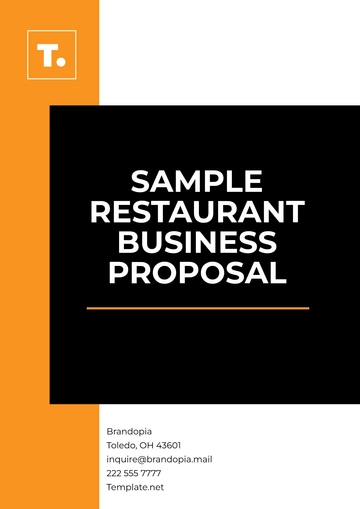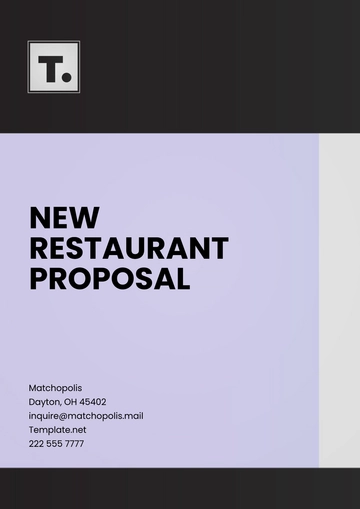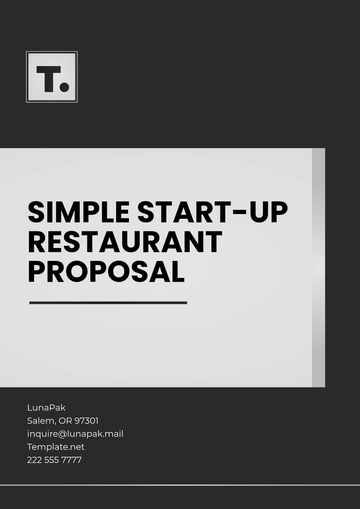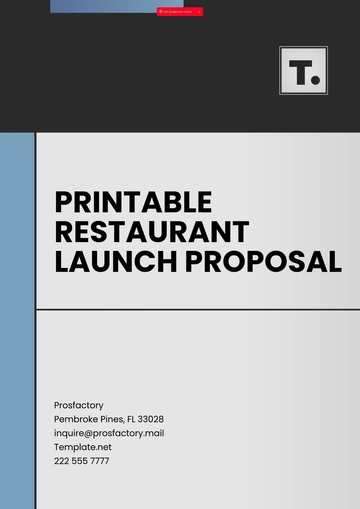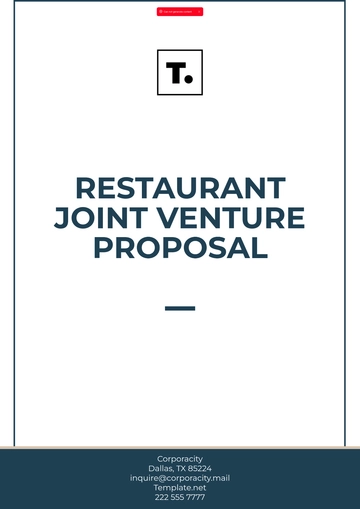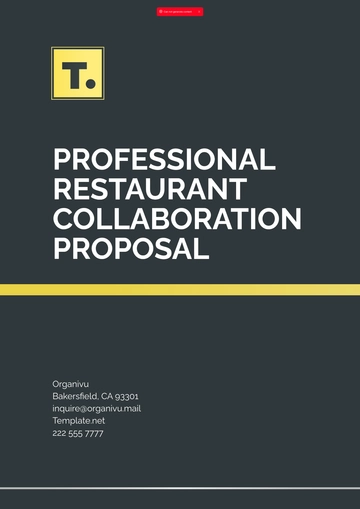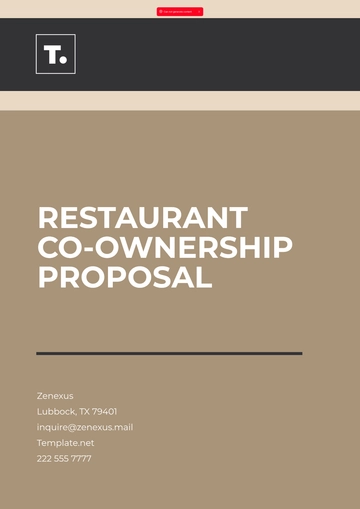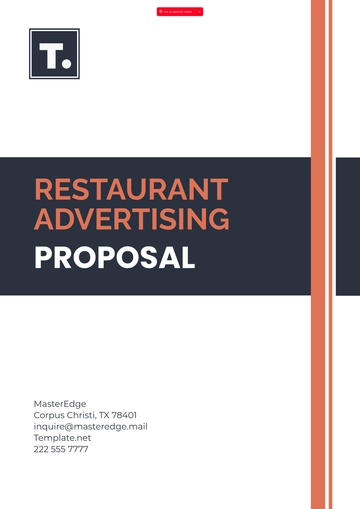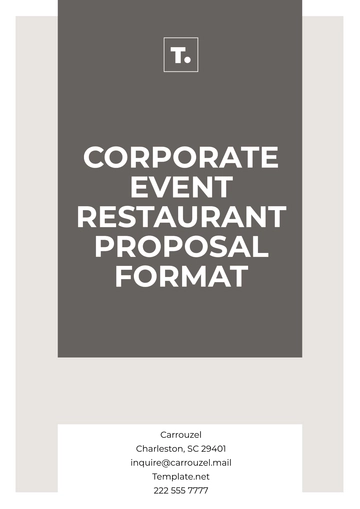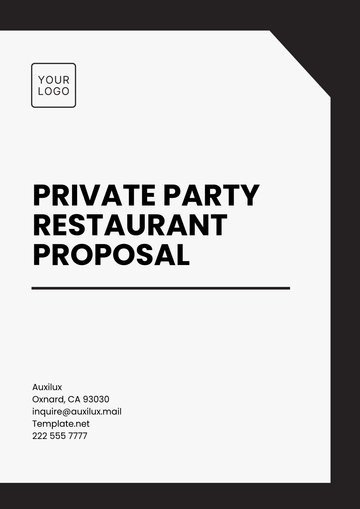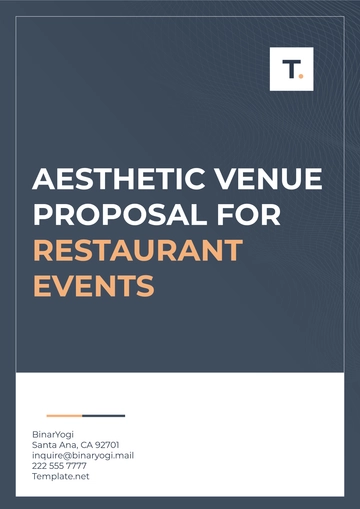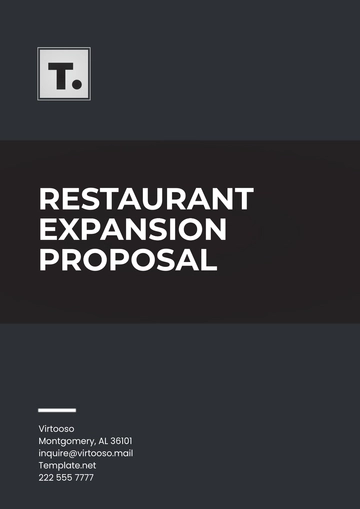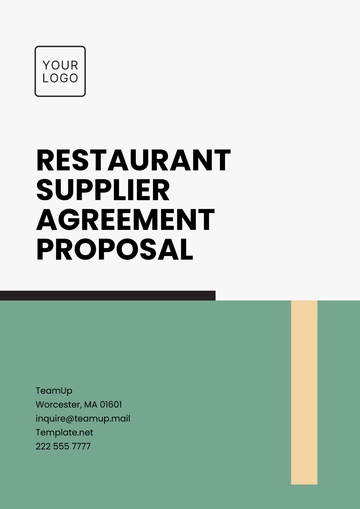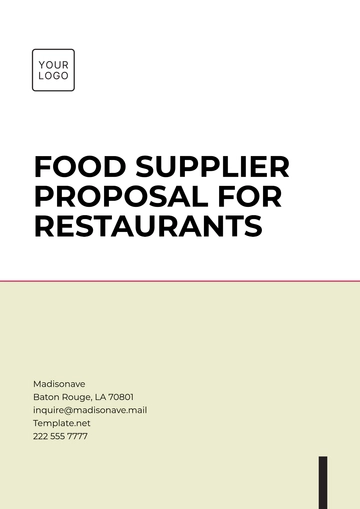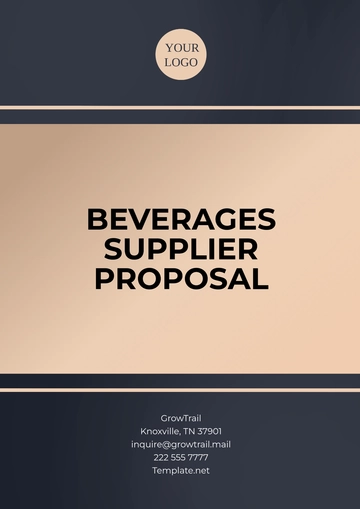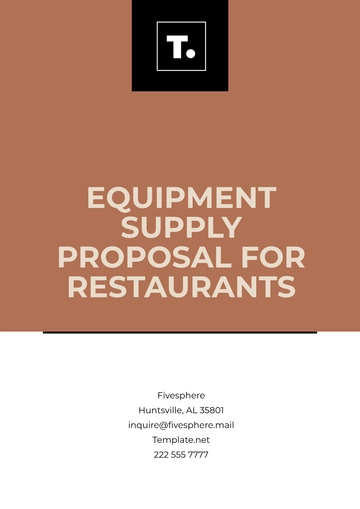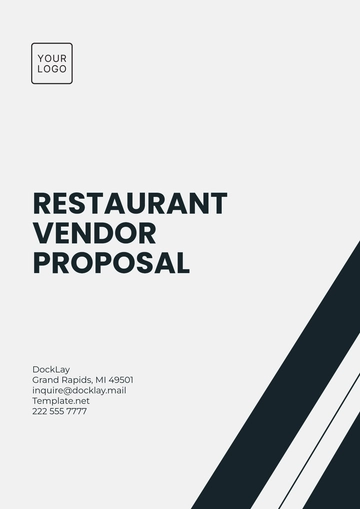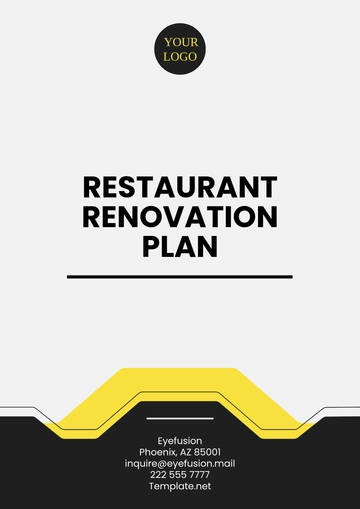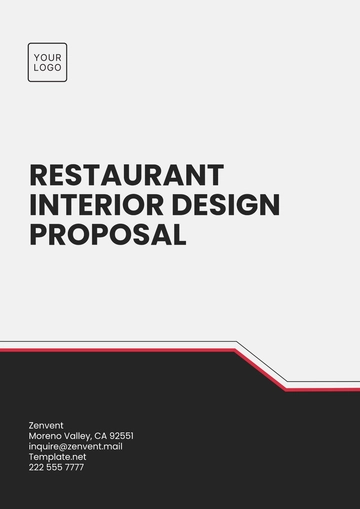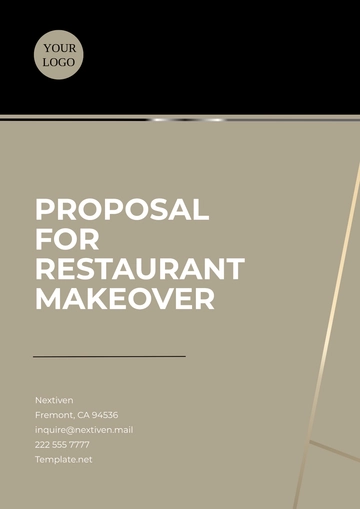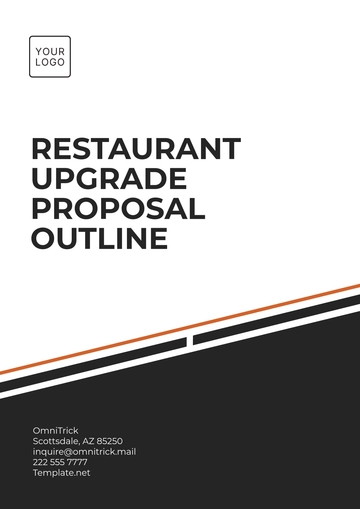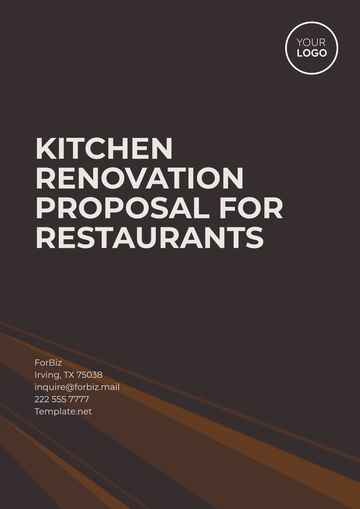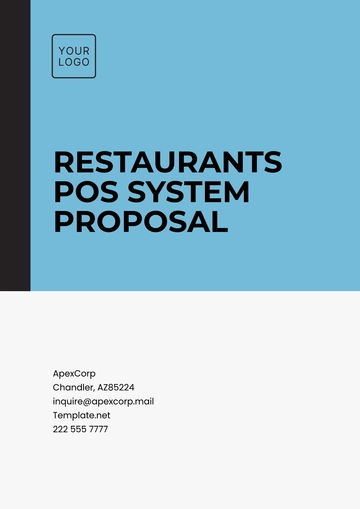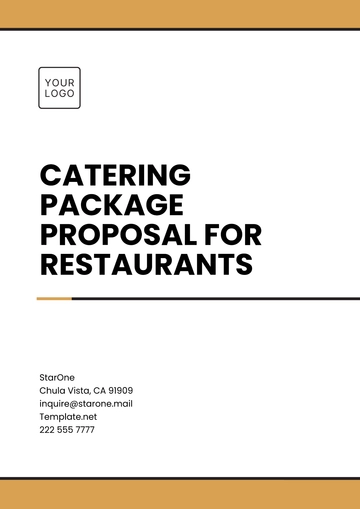Free Restaurant Strategy Proposal

I. Executive Summary
A. Introduction
[Your Company Name], a distinguished culinary establishment renowned for its commitment to gastronomic excellence and unparalleled dining experiences, presents this comprehensive Restaurant Strategy Proposal. With a rich legacy of culinary innovation and a steadfast dedication to customer satisfaction, [Your Company Name] seeks to embark on a transformative journey to fortify its market presence, optimize operational efficiency, and foster sustainable growth in an ever-evolving industry landscape. Through strategic foresight and meticulous planning, [Your Company Name] endeavors to reaffirm its position as a trailblazer in the culinary domain, setting new standards of excellence and innovation.
B. Objectives
Enhance Customer Satisfaction: At the heart of [Your Company Name]'s strategy lies a relentless pursuit of enhancing customer satisfaction. With a targeted goal of achieving a [15%] improvement in customer satisfaction scores within [6 months], [Your Company Name] aims to surpass customer expectations by delivering personalized service, culinary mastery, and memorable dining experiences.
Increase Monthly Revenue: Fueling [Your Company Name]'s growth aspirations is a strategic imperative to augment monthly revenue streams. Through innovative menu offerings, operational optimizations, and targeted marketing initiatives, [Your Company Name] aims to realize a substantial [$10,000] increase in monthly revenue within [1 year], thereby securing a sustainable pathway to financial prosperity.
Expand Market Reach: Embracing the ethos of expansion and diversification, [Your Company Name] envisages strategic growth opportunities to penetrate new markets and demographics. With plans to open [2] new locations within [2 years], [Your Company Name] seeks to extend its culinary footprint, captivate new audiences, and solidify its position as a leading culinary destination.
C. Strategy Overview
[Your Company Name]'s proposed strategy embodies a holistic and multifaceted approach that encompasses menu innovation, operational excellence, and targeted marketing initiatives. By synergistically aligning these strategic pillars with [Your Company Name]'s core values, market insights, and emerging trends, this strategy aims to unlock new avenues for growth, foster enduring customer relationships, and reinforce [Your Company Name]'s reputation as a culinary vanguard.
II. Current Situation Analysis
A. Market Analysis
Market Trends:
Shift towards Healthier Dining Options: The contemporary dining landscape reflects a growing consumer inclination towards health-conscious eating habits and sustainable food choices. This trend underscores the burgeoning demand for plant-based and nutrient-rich menu offerings, presenting [Your Company Name] with an opportunity to curate innovative dishes that resonate with health-conscious consumers.
Emergence of Digital Dining Platforms: The advent of digital dining platforms has revolutionized the way consumers interact with restaurants, offering unparalleled convenience and accessibility. In light of this paradigm shift, [Your Company Name] must embrace digitalization and harness the power of online ordering, delivery services, and reservation platforms to enhance customer engagement and drive revenue growth.
Preference for Local and Authentic Culinary Experiences: In an era characterized by globalization and culinary fusion, there is a discernible preference among consumers for authentic, locally-sourced culinary experiences that celebrate regional flavors and cultural heritage. [Your Company Name] can leverage its culinary expertise and commitment to quality to capitalize on this trend, showcasing its unique offerings and artisanal craftsmanship to discerning diners.
B. SWOT Analysis
Strengths
Established Brand Reputation: [Your Company Name] enjoys a sterling reputation and brand equity in the culinary sphere, owing to its legacy of culinary excellence, impeccable service, and unwavering commitment to quality.
Diverse Menu Offerings: With a diverse repertoire of culinary creations spanning various cuisines, dietary preferences, and culinary techniques, [Your Company Name] caters to a wide spectrum of tastes and preferences, thereby appealing to a broad and discerning clientele.
Loyal Customer Base: [Your Company Name] boasts a loyal and discerning customer base that appreciates its culinary innovations, immersive dining experiences, and unparalleled hospitality, fostering long-term customer loyalty and advocacy.
Weaknesses
Operational Inefficiencies: Despite [Your Company Name]'s culinary prowess and reputation, operational inefficiencies and bottlenecks may hinder the seamless delivery of exceptional dining experiences. These inefficiencies may manifest in kitchen workflow challenges, inventory management issues, and service delivery lapses, detracting from the overall guest experience.
Limited Online Presence: In an increasingly digitalized marketplace, [Your Company Name] may lag behind competitors in terms of online visibility, digital engagement, and e-commerce capabilities. A suboptimal online presence may impede [Your Company Name]'s ability to reach and connect with tech-savvy consumers, resulting in missed opportunities for customer acquisition and revenue growth.
Seasonal Variability: [Your Company Name]'s reliance on seasonal ingredients and menu rotations, while emblematic of its commitment to culinary freshness and seasonality, may introduce inherent challenges related to menu consistency, availability, and supply chain management, potentially affecting operational stability and customer satisfaction.
Opportunities
Growing Demand for Healthy Eating: The escalating global emphasis on health and wellness has spurred a burgeoning demand for healthier dining options, including plant-based, organic, and sustainably-sourced fare. By aligning with this prevailing consumer trend, [Your Company Name] can capitalize on the growing market for health-conscious dining experiences, introducing innovative menu offerings that cater to evolving dietary preferences and lifestyle choices.
Expansion into New Markets: With an eye towards expansion and diversification, [Your Company Name] can explore strategic growth opportunities to penetrate new geographic markets, demographic segments, and culinary niches. By expanding its footprint and establishing a presence in high-growth markets, [Your Company Name] can broaden its customer base, drive revenue growth, and fortify its position as a formidable player in the culinary landscape.
Digital Marketing Strategies: In an era dominated by digital connectivity and social media influence, [Your Company Name] can leverage digital marketing channels, social media platforms, and e-commerce solutions to amplify its brand presence, engage with consumers on a deeper level, and cultivate brand loyalty. By deploying targeted digital marketing campaigns, personalized content strategies, and interactive online experiences, [Your Company Name] can enhance its visibility, attract new customers, and foster meaningful connections with its audience.
Threats
Intense Competition: The restaurant industry is characterized by intense competition and market saturation, with a proliferation of dining options spanning various cuisines, formats, and price points. As such, [Your Company Name] faces formidable competition from established restaurant chains, independent eateries, and emerging culinary concepts, all vying for consumers' discretionary spending and dining preferences.
Economic Uncertainty: In an era marked by economic volatility and macroeconomic uncertainty, [Your Company Name] must navigate potential headwinds arising from fluctuating consumer spending patterns, inflationary pressures, and geopolitical disruptions. Economic downturns, recessionary pressures, and unforeseen market shocks may dampen consumer confidence and discretionary spending, impacting [Your Company Name]'s revenue streams and financial performance.
Regulatory Changes: The restaurant industry is subject to a myriad of regulatory requirements, food safety standards, and compliance mandates, which may evolve over time in response to changing consumer preferences, public health concerns, and legislative initiatives. [Your Company Name] must remain vigilant and adaptable in the face of regulatory changes, ensuring compliance with industry standards, sanitation protocols, and food safety regulations to uphold operational integrity and consumer trust.
III. Proposed Strategy
A. Menu Innovation
Introduction of New Seasonal Dishes:
[Your Company Name] plans to introduce [8] new seasonal dishes to its menu rotation, leveraging seasonal ingredients and culinary trends to delight discerning diners. These innovative offerings will showcase [Your Company Name]'s culinary creativity and commitment to freshness, enticing guests with exciting flavor profiles and seasonal specialties.
Expansion of Vegetarian and Vegan Options:
Recognizing the growing demand for plant-based dining options, [Your Company Name] will expand its vegetarian and vegan offerings to cater to health-conscious consumers and dietary preferences. By curating a diverse selection of plant-based dishes, [Your Company Name] aims to appeal to a broader demographic while promoting sustainability and wellness.
Collaboration with Local Suppliers:
[Your Company Name] will forge strategic partnerships with local farmers, producers, and artisans to source fresh, sustainable ingredients for its culinary creations. By prioritizing locally-sourced ingredients, [Your Company Name] can support the local economy, reduce its environmental footprint, and offer guests authentic, farm-to-table dining experiences.
B. Operational Streamlining
Implementation of Kitchen Automation:
To enhance operational efficiency and streamline kitchen workflows, [Your Company Name] will invest in kitchen automation technologies, such as automated food prep stations, robotic kitchen assistants, and smart inventory management systems. By automating repetitive tasks and optimizing resource utilization, [Your Company Name] aims to reduce wait times, improve food consistency, and enhance overall operational productivity.
Staff Training Programs:
[Your Company Name] will implement comprehensive staff training programs focusing on service excellence, culinary skills development, and operational best practices. Through ongoing training and professional development initiatives, [Your Company Name] seeks to empower its team members with the knowledge, skills, and confidence to deliver exceptional dining experiences, foster customer loyalty, and drive operational excellence.
Adoption of Inventory Management Software:
[Your Company Name] will deploy advanced inventory management software to optimize inventory control, minimize waste, and streamline procurement processes. By leveraging real-time inventory tracking, demand forecasting, and supplier management functionalities, [Your Company Name] can ensure optimal stock levels, reduce food waste, and mitigate inventory-related costs.
C. Marketing Initiatives
Launching a Mobile App:
[Your Company Name] will develop and launch a dedicated mobile app to enhance customer engagement, facilitate online ordering, and reward loyal patrons. The mobile app will offer features such as streamlined reservation booking, personalized recommendations, and exclusive promotions, providing guests with a seamless and convenient dining experience while fostering brand loyalty and repeat business.
Social Media Campaigns:
[Your Company Name] will leverage social media platforms, such as Instagram, Facebook, and Twitter, to engage with customers, showcase culinary creations, and promote special events. By curating visually appealing content, hosting interactive campaigns, and leveraging user-generated content, [Your Company Name] aims to amplify its brand presence, cultivate a vibrant online community, and drive customer acquisition and retention.
Email Marketing:
[Your Company Name] will implement targeted email marketing campaigns to communicate exclusive offers, promotions, and seasonal menus to its customer base. By segmenting email lists, personalizing content, and leveraging marketing automation tools, [Your Company Name] can deliver relevant and timely messaging that resonates with customers, drives traffic to its establishments, and stimulates repeat visits and purchases.
IV. Implementation Plan
A. Timeline
Initiative | Timeline |
|---|---|
Menu Innovation | Month 1-2 |
Operational Streamlining | Month 3-4 |
Marketing Initiatives | Month 5 |
B. Resource Allocation
Budget Allocation:
[Your Company Name] will allocate a budget of [$100,000] towards menu innovation, operational streamlining, and marketing initiatives. This investment will encompass expenses related to ingredient procurement, technology investments, staff training, and marketing campaigns.
Staff Training Hours:
[Your Company Name] will allocate [100 hours] of staff training over a period of [2 months] to ensure that team members are equipped with the necessary skills and knowledge to implement the proposed strategies effectively. Training sessions will cover topics such as customer service excellence, culinary techniques, kitchen automation systems, inventory management, and digital marketing tools.
C. Key Performance Indicators (KPIs)
Customer Satisfaction Scores:
[Your Company Name] will monitor and evaluate customer satisfaction scores on a regular basis, aiming to achieve a [15%] improvement within [6 months]. Key metrics will include customer feedback ratings, online reviews, and Net Promoter Score (NPS) surveys. To measure customer satisfaction, [Your Company Name] will implement post-dining surveys, feedback forms, and guest comment cards, encouraging patrons to provide feedback on their dining experiences.
Monthly Revenue Growth:
[Your Company Name] will track monthly revenue growth metrics, targeting a [$10,000] increase in monthly revenue within [1 year]. Key indicators will include total sales revenue, average transaction value, and revenue per available seat. [Your Company Name] will analyze sales data, transaction records, and financial reports to identify revenue trends, revenue drivers, and areas for revenue optimization. In addition, [Your Company Name] will conduct regular financial reviews and performance assessments to ensure alignment with revenue targets and business objectives.
Number of New Customer Acquisitions:
[Your Company Name] will measure the number of new customer acquisitions resulting from marketing initiatives and menu innovations, aiming to expand its customer base and reach new demographic segments. Key metrics will include customer acquisition rates, new customer sign-ups, and guest demographics analysis. [Your Company Name] will utilize customer relationship management (CRM) software and guest database analytics to track customer acquisition metrics, segment customer profiles, and personalize marketing campaigns. Furthermore, [Your Company Name] will implement referral programs, loyalty incentives, and targeted promotions to attract new customers and encourage repeat visits.
V. Risk Management
A. Identification of Risks
Risk Category | Potential Risks |
|---|---|
Operational Risks | Kitchen equipment breakdown, staff shortages |
Market Risks | Fluctuations in consumer preferences, economic downturns |
Financial Risks | Cost overruns, revenue shortfalls |
Regulatory Risks | Non-compliance with food safety regulations |
B. Risk Assessment
Operational Risks:
[Your Company Name] will conduct regular maintenance checks on kitchen equipment and establish contingency plans to address equipment failures promptly. Additionally, [Your Company Name] will implement cross-training programs to mitigate the impact of staff shortages and ensure operational continuity.
Market Risks:
To mitigate the impact of fluctuating consumer preferences, [Your Company Name] will maintain flexibility in menu offerings and conduct market research to anticipate changing trends. In response to economic downturns, [Your Company Name] will implement cost-saving measures and promotional strategies to maintain customer traffic and revenue levels.
Financial Risks:
[Your Company Name] will closely monitor budget expenditures and implement cost-control measures to prevent cost overruns. In the event of revenue shortfalls, [Your Company Name] will explore alternative revenue streams and adjust pricing strategies accordingly to maintain financial stability.
Regulatory Risks:
[Your Company Name] will stay updated on food safety regulations and ensure compliance with local health codes and licensing requirements. Regular staff training sessions will be conducted to reinforce adherence to food safety protocols and mitigate the risk of regulatory violations.
C. Risk Mitigation Strategies
Operational Risks: Implement preventive maintenance schedules, establish backup equipment, and cross-train staff to mitigate operational disruptions.
Market Risks: Maintain menu flexibility, conduct regular market research, and implement promotional strategies to adapt to changing consumer preferences and economic conditions.
Financial Risks: Monitor budget performance, implement cost-saving measures, and explore alternative revenue streams to maintain financial stability.
Regulatory Risks: Stay updated on regulatory requirements, conduct regular staff training on food safety protocols, and maintain detailed records to ensure compliance with regulations.
VI. Monitoring and Evaluation
A. Monitoring Mechanisms
Regular Performance Reviews: [Your Company Name] will conduct periodic reviews of key performance indicators (KPIs) to assess progress towards objectives and identify areas for improvement.
Operational Audits: [Your Company Name] will conduct regular operational audits to evaluate compliance with standard operating procedures (SOPs) and identify opportunities for optimization.
Customer Feedback Analysis: [Your Company Name] will analyze customer feedback, online reviews, and satisfaction surveys to gauge customer sentiment and address any issues or concerns promptly.
B. Evaluation Criteria
Achievement of Objectives: [Your Company Name] will evaluate the extent to which objectives outlined in the proposal have been met within the specified timeframe.
Financial Performance: [Your Company Name] will assess revenue growth, profitability, and cost-effectiveness to ensure financial viability and sustainability.
Customer Satisfaction: [Your Company Name] will measure customer satisfaction scores, retention rates, and loyalty metrics to gauge the success of initiatives aimed at enhancing the guest experience.
Operational Efficiency: [Your Company Name] will evaluate operational metrics such as kitchen throughput, table turnover rates, and staff productivity to identify areas for operational improvement and efficiency gains.
C. Review Frequency
Quarterly Performance Reviews: [Your Company Name] will conduct comprehensive performance reviews on a quarterly basis to track progress, identify trends, and make data-driven decisions.
Continuous Monitoring: [Your Company Name] will implement continuous monitoring mechanisms to promptly identify and address any emerging issues or opportunities for improvement.
D. Adjustment and Adaptation
[Your Company Name] will remain agile and responsive to changing market dynamics, customer preferences, and operational challenges. Based on the findings of monitoring and evaluation efforts, [Your Company Name] will make necessary adjustments to strategies, initiatives, and resource allocations to optimize performance and achieve long-term success.
VII. Budget and Financial Projections
A. Budget Allocation
Initiative | Budget Allocation (USD) |
|---|---|
Menu Innovation | $40,000 |
Operational Streamlining | $30,000 |
Marketing Initiatives | $30,000 |
Contingency | $10,000 |
Total | $110,000 |
B. Financial Projections
Revenue Projections:
Year | Revenue (USD) |
|---|---|
Year 1 | $600,000 |
Year 2 | $720,000 |
Year 3 | $860,000 |
Cost Projections:
Initiative | Projected Cost (USD) |
|---|---|
Menu Innovation | $40,000 |
Operational Streamlining | $30,000 |
Marketing Initiatives | $30,000 |
Contingency | $10,000 |
Total Projected Costs | $110,000 |
Profitability Projections:
Metric | Percentage (%) |
|---|---|
Gross Profit Margin | 65% |
Net Profit Margin | 15% |
C. Funding Sources
Internal Funding:
[Your Company Name] will allocate internal resources and reinvest profits to fund a portion of the proposed initiatives.
External Financing:
[Your Company Name] may explore external financing options, such as bank loans or investors, to secure additional capital for strategic initiatives and expansion plans.
D. Contingency Plan
[Your Company Name] has allocated $10,000 as a contingency fund to address unforeseen expenses or challenges that may arise during the implementation period. This fund will provide flexibility and resilience in managing unexpected circumstances while minimizing disruptions to planned initiatives.
VIII. Conclusion
[Your Company Name] is poised to embark on an exciting journey of transformation and growth, fueled by a comprehensive Restaurant Strategy Proposal aimed at revitalizing its market presence, enhancing operational efficiency, and driving sustainable revenue growth. By aligning strategic objectives with market insights, consumer trends, and emerging opportunities, [Your Company Name] is primed to reinforce its position as a culinary leader and set new benchmarks of excellence in the industry.
Through menu innovation, operational streamlining, and targeted marketing initiatives, [Your Company Name] will elevate the dining experience, captivate new audiences, and foster enduring customer relationships. With a steadfast commitment to culinary excellence, customer satisfaction, and operational integrity, [Your Company Name] is well-positioned to achieve its objectives and realize its vision of culinary innovation and hospitality excellence.
With the support of its dedicated team, loyal patrons, and strategic partners, [Your Company Name] looks forward to a future filled with culinary creativity, memorable dining experiences, and sustained growth. Together, we will write the next chapter in [Your Company Name]'s illustrious culinary legacy, shaping a brighter, more flavorful future for all who dine with us.
- 100% Customizable, free editor
- Access 1 Million+ Templates, photo’s & graphics
- Download or share as a template
- Click and replace photos, graphics, text, backgrounds
- Resize, crop, AI write & more
- Access advanced editor
Plan for success with Template.net's Restaurant Strategy Proposal Template. This customizable document offers a structured format for presenting strategic initiatives, goals, and action plans for your restaurant business. Covering areas such as market analysis, competitive positioning, marketing strategies, and growth objectives. Enhance alignment and clarity in strategic decision-making. Editable in our Ai Editor Tool for seamless customization to reflect your restaurant's unique strategy and objectives.
You may also like
- Business Proposal
- Research Proposal
- Proposal Request
- Project Proposal
- Grant Proposal
- Photography Proposal
- Job Proposal
- Budget Proposal
- Marketing Proposal
- Branding Proposal
- Advertising Proposal
- Sales Proposal
- Startup Proposal
- Event Proposal
- Creative Proposal
- Restaurant Proposal
- Blank Proposal
- One Page Proposal
- Proposal Report
- IT Proposal
- Non Profit Proposal
- Training Proposal
- Construction Proposal
- School Proposal
- Cleaning Proposal
- Contract Proposal
- HR Proposal
- Travel Agency Proposal
- Small Business Proposal
- Investment Proposal
- Bid Proposal
- Retail Business Proposal
- Sponsorship Proposal
- Academic Proposal
- Partnership Proposal
- Work Proposal
- Agency Proposal
- University Proposal
- Accounting Proposal
- Real Estate Proposal
- Hotel Proposal
- Product Proposal
- Advertising Agency Proposal
- Development Proposal
- Loan Proposal
- Website Proposal
- Nursing Home Proposal
- Financial Proposal
- Salon Proposal
- Freelancer Proposal
- Funding Proposal
- Work from Home Proposal
- Company Proposal
- Consulting Proposal
- Educational Proposal
- Construction Bid Proposal
- Interior Design Proposal
- New Product Proposal
- Sports Proposal
- Corporate Proposal
- Food Proposal
- Property Proposal
- Maintenance Proposal
- Purchase Proposal
- Rental Proposal
- Recruitment Proposal
- Social Media Proposal
- Travel Proposal
- Trip Proposal
- Software Proposal
- Conference Proposal
- Graphic Design Proposal
- Law Firm Proposal
- Medical Proposal
- Music Proposal
- Pricing Proposal
- SEO Proposal
- Strategy Proposal
- Technical Proposal
- Coaching Proposal
- Ecommerce Proposal
- Fundraising Proposal
- Landscaping Proposal
- Charity Proposal
- Contractor Proposal
- Exhibition Proposal
- Art Proposal
- Mobile Proposal
- Equipment Proposal
- Student Proposal
- Engineering Proposal
- Business Proposal

